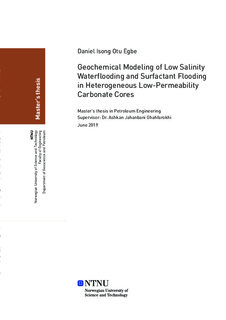| dc.description.abstract | World energy consumption is projected to increase significantly by 2040 with fossil fuels remaining the main source of energy. About 60% and 40% of the world’s oil and gas reserves, respectively, are found in carbonate reservoirs, however, on average only 30% of each is recovered during primary recovery. In addition, most of the large discoveries are in decline and newer discoveries are mostly smaller or satellite fields. The growing
demand for energy and the lack of many new large discoveries underscores the need for maximising oil recovery from already mature fields. The low primary recovery also offers a huge potential for improved oil recovery (IOR).
Waterflooding has been the most widely used technique to improve recovery from oil reservoirs worldwide through pressure support. Recently, there has been a significant growth in interest in the chemistry and ionic composition of the injected water. Low salinity waterflooding (LSWF) is a relatively recent enhanced oil recovery (EOR) technique that has the ability to alter the crude oil/brine/rock (COBR) interactions and improve oil recovery in both clastics and carbonates. Combining low salinity waterflooding with other EOR methods such as surfactant flooding in a hybrid EOR process could also be beneficial for surfactants. In a low salinity environment, the phase behavior of surfactants is improved; making them more effective at mobilizing oil trapped by capillary forces.
This thesis models low salinity water and low salinity surfactant coreflood experiments based on the geochemical interactions that occur during the processes. An equation-ofstate (EOS), compositional simulator GEM™ by CMG was used to perform numerical simulations. A history match of two coreflood experiments done on heterogeneous lowpermeability carbonate cores has been performed, after which sensitivity analysis was conducted on many key parameters to investigate their effects on the results. A detailed analysis of the results has been done for all the modeling cases.
Wettability alteration was assumed to be the mechanism responsible for the increase in oil recovery during low salinity waterflooding, such that relative permeability interpolation based on the ion exchange equivalent fraction of magnesium ion was used for the history matching. The ability of surfactants to mobilize capillary trapped oil during surfactant flooding was modeled using capillary number-based relative permeability interpolation. Interpolations based on both the ion exchange equivalent fraction of magnesium and the capillary number were used to model the hybrid low salinity surfactant process. A successful history match of experimental oil recovery and pressure drop was obtained for low salinity waterflooding. The final oil recovery from the low salinity surfactant case was also found to match the experimental results. However, the desired effect was not observed for the individual processes in the case of lowsalinity surfactant flooding because the simulator currently lacks the ability to interpolate between rock regions. Nevertheless, the combined process resulted in a higher oil recovery than the individual processes.
A sensitivity study on the timing of low salinity water injection revealed that the earlier the onset of low salinity waterflooding, the higher the oil recovery. Significantly higher oil recovery was observed for secondary mode low salinity waterflooding compared to seawater flooding. A sensitivity study also revealed that the injection rate is a crucial parameter in optimizing oil recovery. The injection temperature was found to have a notable effect on intra-aqueous, mineral reactions and pH, and should therefore be an integral part of all modeling and simulation studies. The use of different mechanistic modeling methods has been investigated, and it revealed that the modeling method used should be based on reservoir properties and experimental results. A decrease in the oil-water interfacial tension (IFT) resulted in a significant increase in oil recovery during surfactant flooding. Finally, a decrease in the adsorption revealed that the lower the surfactant adsorption, the earlier the effect of surfactant on oil recovery and pressure drop is observed. | |
